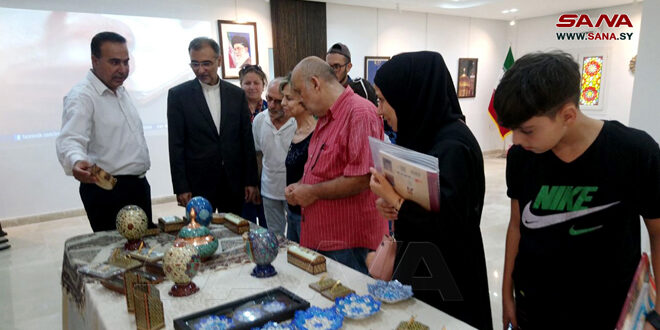The Cultural Center of the Embassy of the Islamic Republic of Iran in Lattakia held today an exhibition of Iranian handicrafts.
The three-day exhibition included a group of Iranian handicrafts such as decorative artistic masterpieces with an Islamic character that are characterized by precision of manufacture and professionalism in drawing, and some paintings that are identical to paintings by famous Iranian artists, in addition to a children’s section that contains stories and entertainment and educational magazines.
Director of the Iranian Cultural Center, Ali Reza Fadavi, told SANA correspondent that holding these exhibitions aims to develop and strengthen cultural relations between people of Iran and Syria, considering that art is the best way to connect people. He noted that the exhibition makes the Syrian people familiar with famous handicrafts in Iran, which reflect the skills and creativity of Iranian craftsmen in various types of industries.
Dr. Mervat Suleiman, a Persian language teacher at Tishreen University and one of the supervisors of the exhibition, pointed out that it is the first of its kind in Lattakia and includes a group of handicrafts from Iranian arts. She indicated that the exhibition includes fabrics made of pure wool with Iranian hand engravings bearing symbols of ancient Iranian civilization, in addition to watches in a hand-crafted frame that contain the biographies of famous kings from the beginning of creation until the advent of Islam.
Suleiman added: The exhibition includes a children’s section that contains meaningful and valuable stories in the Arabic language that suit our society and are characterized by high quality in terms of artistic production, paper quality and drawings, in addition to a group of Iranian mental games that nourish the child’s culture and develop his mental abilities.
In a meeting with visitors, the artist Atlal Shamlat expressed her admiration for the exhibition and considered it an opportunity to learn about Persian culture and Iranian civilization in addition to exchanging experiences in joint works of handicrafts and arts.
In turn, the artist Adwiya Daiop pointed out that the exhibition provides an opportunity to learn about vocabulary and decorative tools from the depth of Iranian culture, the mechanism of work and the various materials that it deals with, indicating that the artworks attract the attention of every artist in light of the diversity between fabric, ceramics and wood.
Inas Abdulkareem

